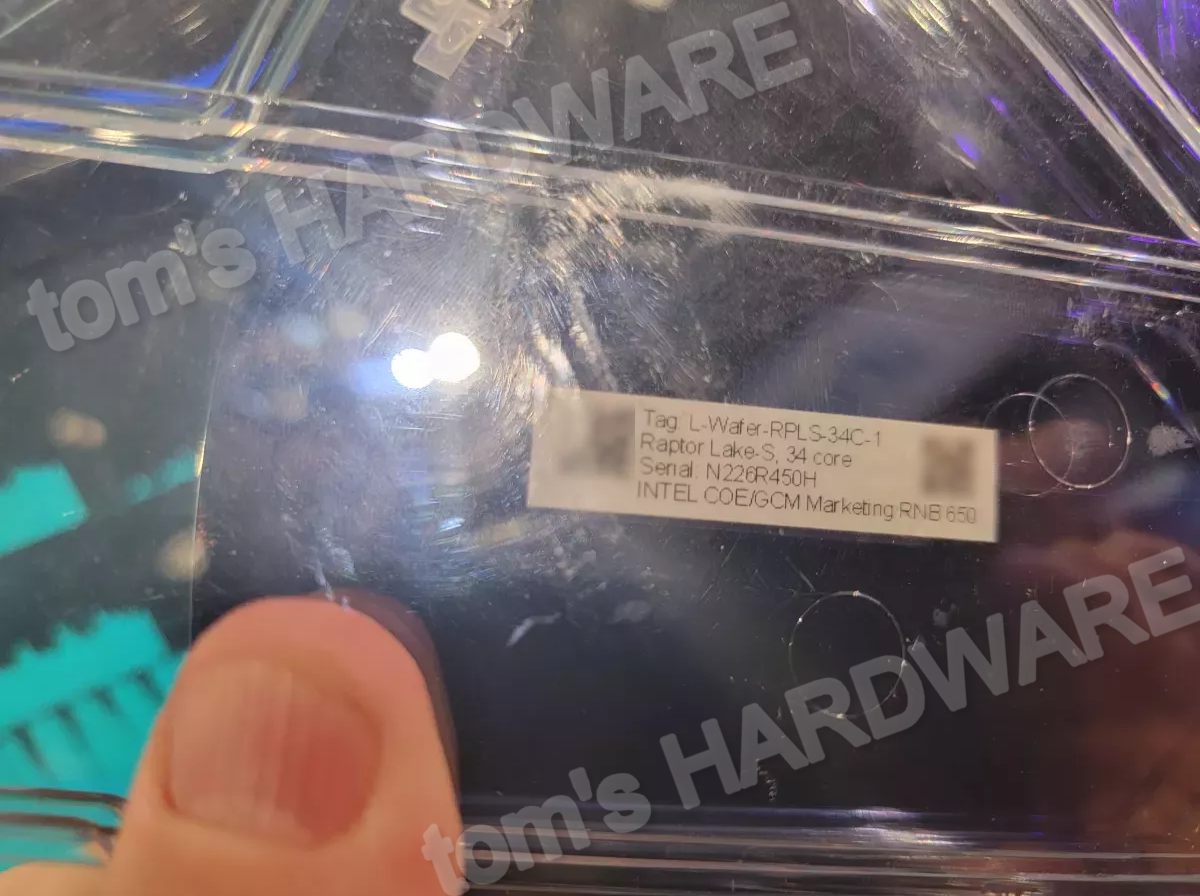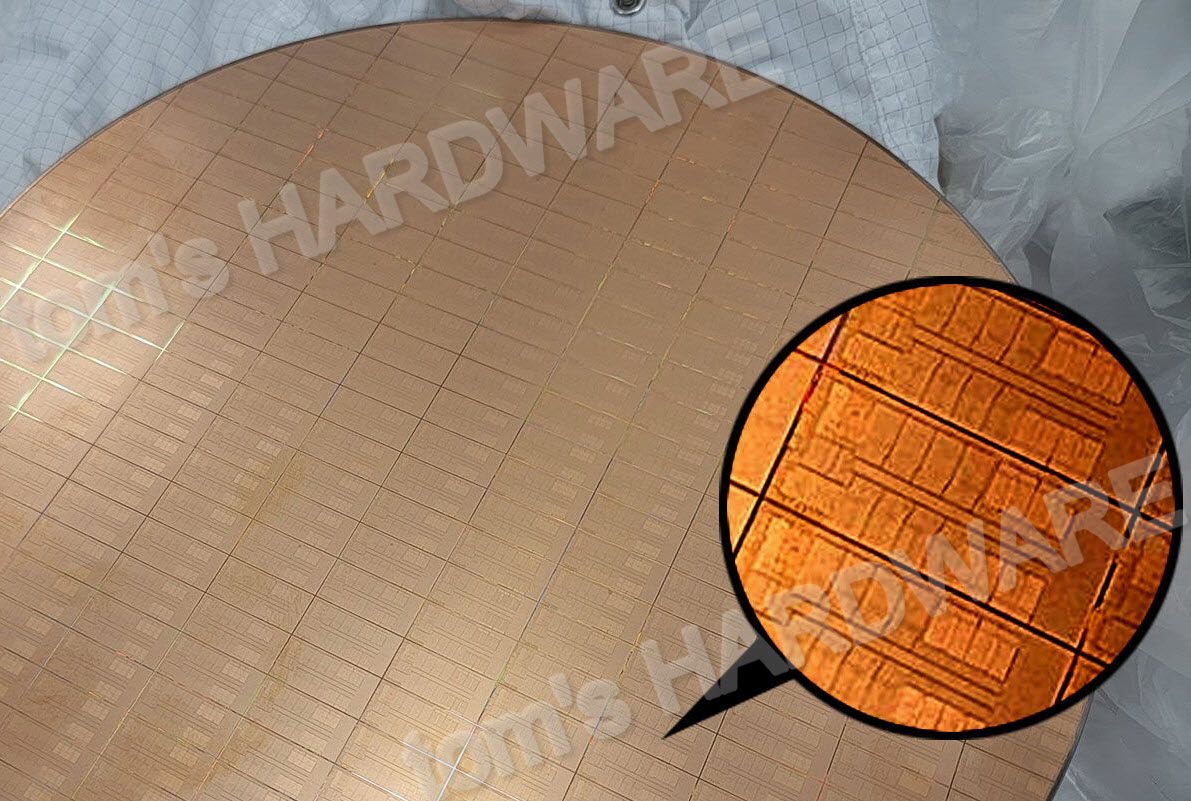Intel's Unannounced 34-Core Raptor Lake CPUs Accidentally Displayed at Innovation 2022
A 34-Core Monster Appears!
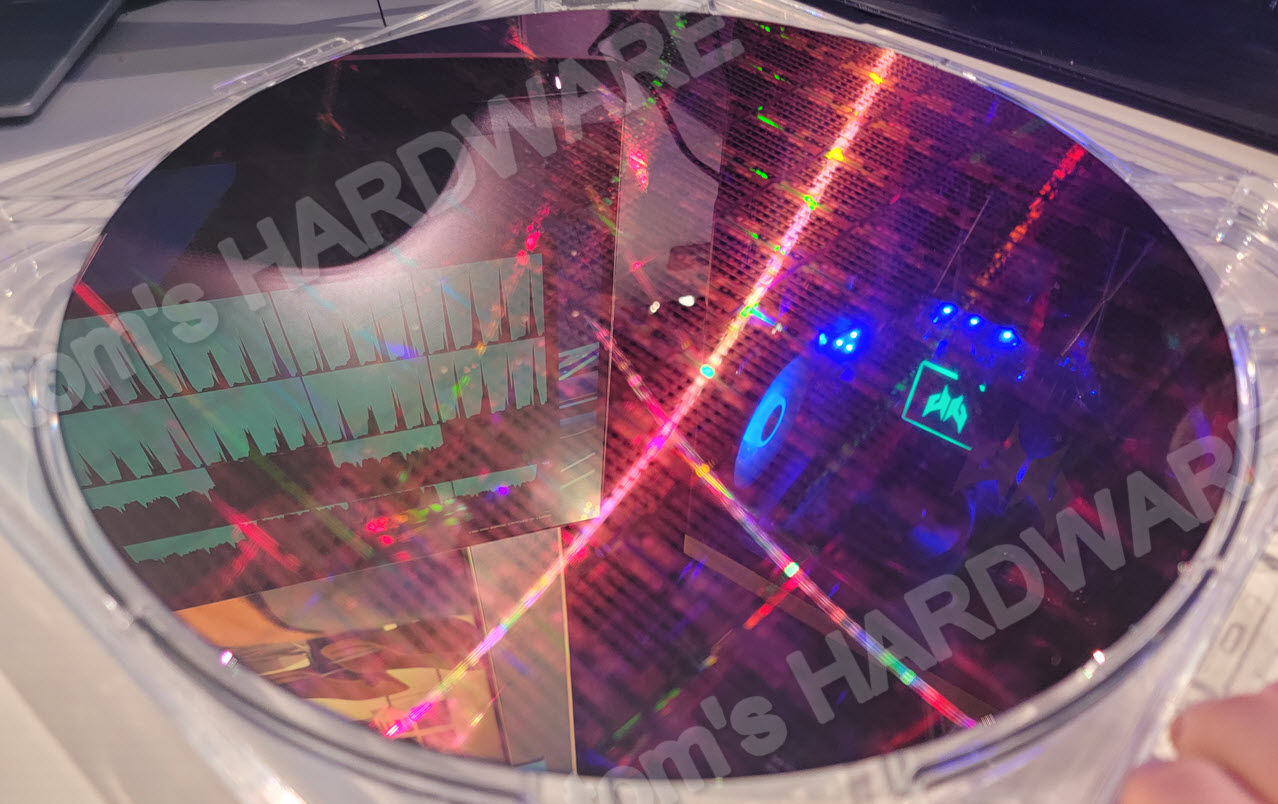
Intel has a wafer full of Raptor Lake dies on display here at Innovation 2022 in San Jose, but after closer examination, it is apparent that the wafer contains 34-core Raptor Lake processors that haven't been announced. It also appears that the wafer was displayed unintentionally. That's exciting because Intel had already announced its Raptor Lake chips earlier today with a peak of 24 cores, but there wasn't any mention of a 34-core model.
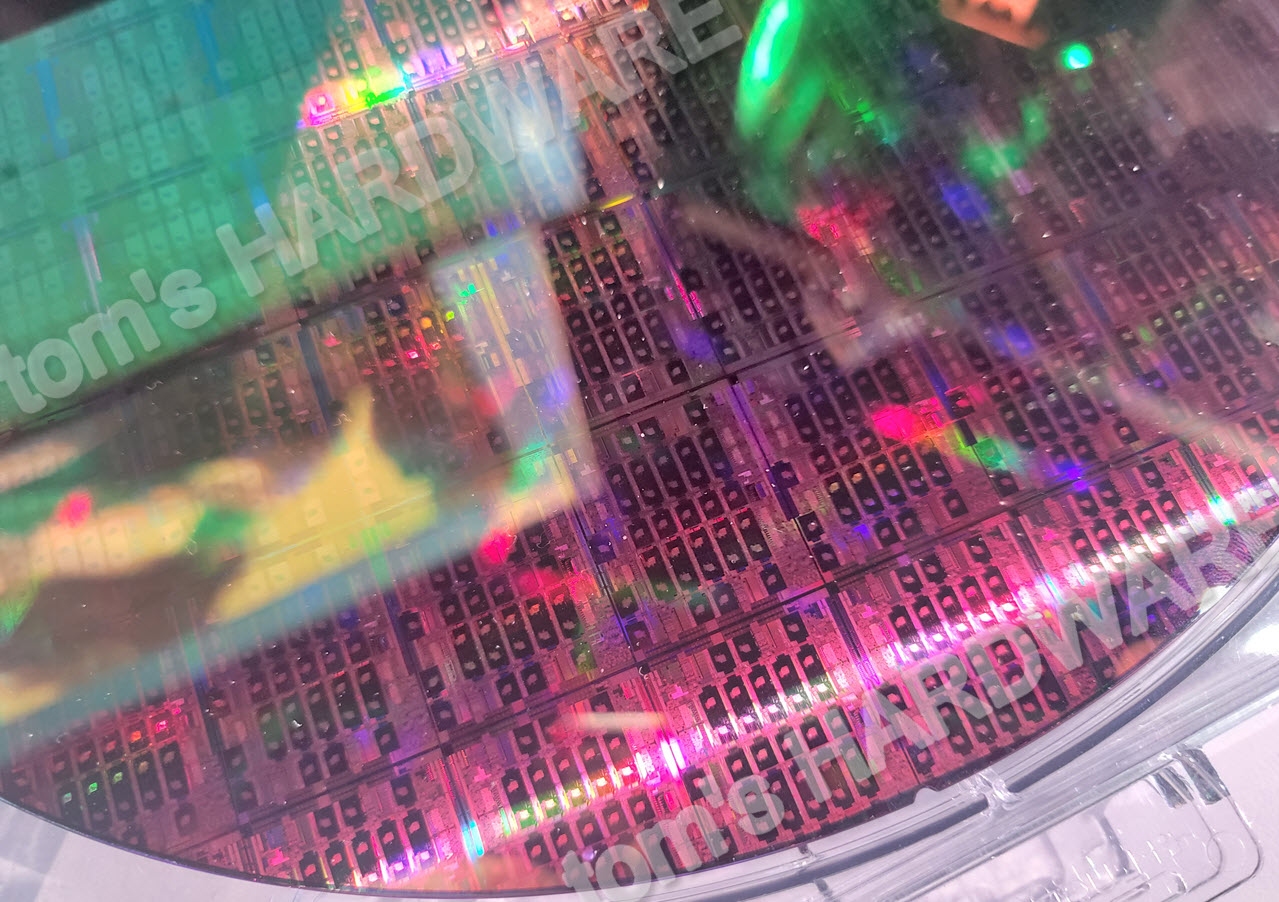
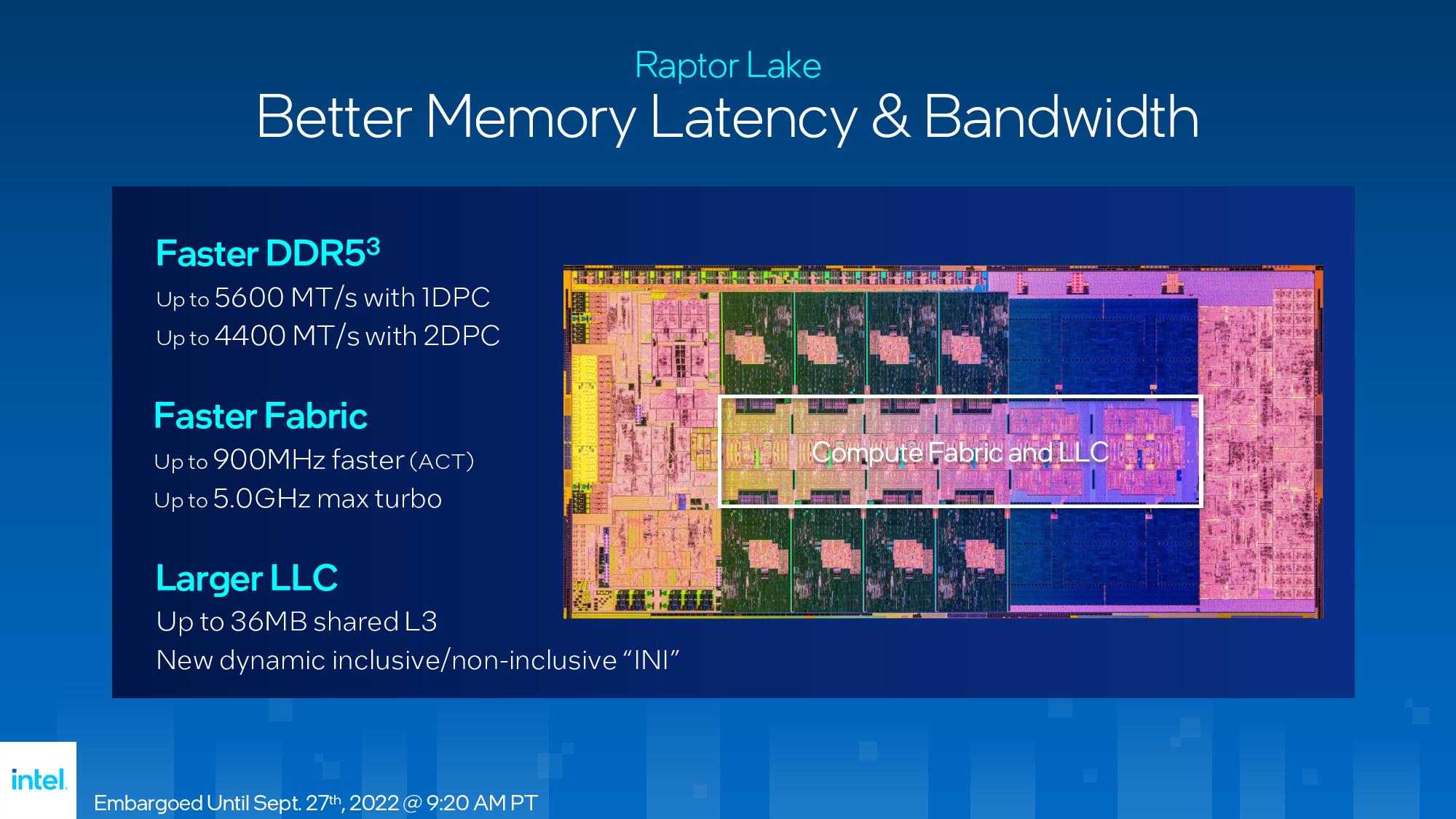
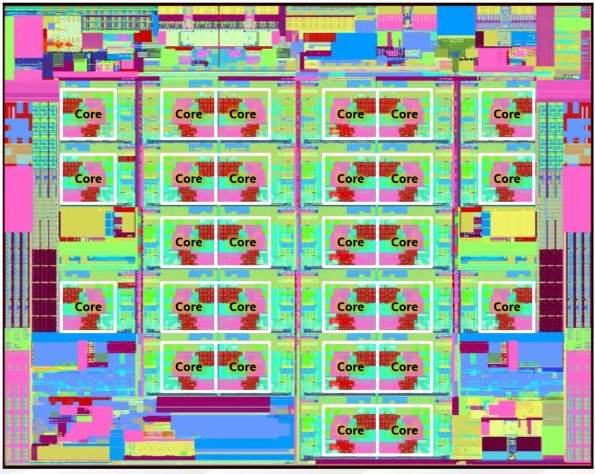
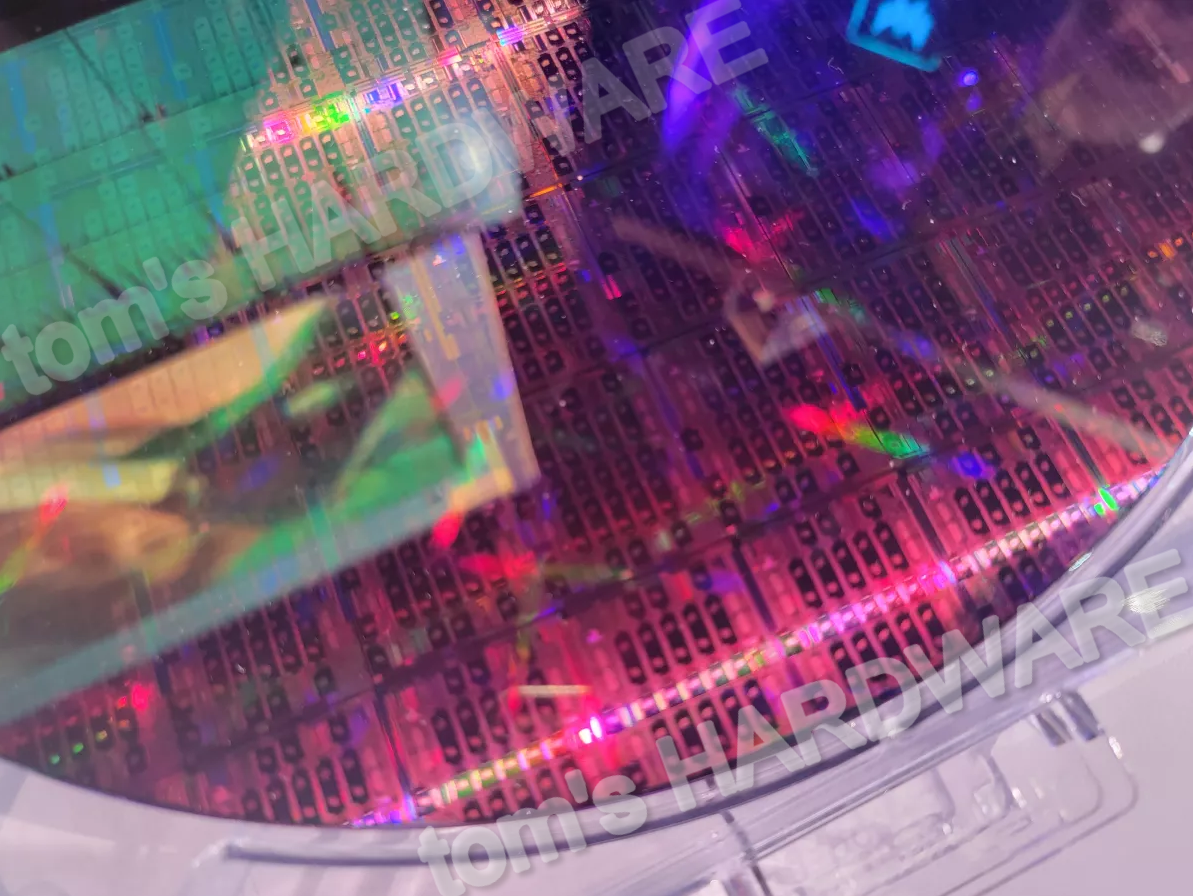
We first discovered the wafer in the booth, and it was readily apparent that the dies were larger than the Raptor Lake desktop dies we saw in Israel. After a discussion with the booth staff and Dr. Ian Cutress of More Than Moore, the booth staff, unaware that these were unreleased CPUs, discovered a label on the carrier and realized that this was a wafer of unreleased CPU silicon.
A closer look at the wafer implies that the design is not of the standard Raptor Lake CPUs. As you can see, the cores aren't aligned horizontally in two rows as we see with the typical Raptor Lake die (you can see an Intel diagram of the Raptor Lake-S desktop chips in the second slide of the above album, and the actual die at the end of the article).
Additionally, the 34 cores appear interconnected with a mesh, like the Ice Lake models (third album image), and not the familiar ring bus we see with Intel's desktop PC chips. We can also make out eight DDR5 memory controllers and what appear to be UPI blocks, all of which are not on the standard desktop PC models.
This is likely what is known as the Sapphire Rapids MCC die, but with Raptor Lake branding for the workstation market. We're working on further clarification.
The booth staff was unaware that this wafer contained unannounced 34-core chips, and there was some confusion about which processors were etched on the wafer. Finally, after some discussion with the booth staff and predictions that these were Ice Lake processors, a staff member showed us proof that the die was of actual Raptor Lake silicon -- the back of the die carrier contains a sticker that makes it clear with a label that says "Raptor Lake-S 34-Core."
The die appears larger than the die that drops into the standard desktop PCs with the LGA 1700 socket, so it appears to be too large to fit inside the package for desktop PCs. That means this is likely a CPU destined for the workstation market.
Additionally, the die contains 34 distinct core areas that appear to be connected by a mesh, meaning these are all likely high-performance cores (p-cores). The design doesn't include quad-core clusters of e-cores as we see with desktop PC models. As a reminder, the peak configuration for the desktop is eight p-cores and 16 e-cores. You can see a picture of the standard Raptor Lake dies for desktop processors below.
Get Tom's Hardware's best news and in-depth reviews, straight to your inbox.

Paul Alcorn is the Editor-in-Chief for Tom's Hardware US. He also writes news and reviews on CPUs, storage, and enterprise hardware.
-
Kamen Rider Blade This could be the return to HEDT / Fish Hawk Falls prototype?Reply
34-core on a Mesh sounds about right for a HEDT class CPU on a new socket. -
emike09 Hopefully this is an HEDT chip! Really ready to upgrade from my i9-10920X Cascade Lake-X but need those PCI-e lanes that 12th and 13th gen don't provide. It'd be nice to finally move up from PCI-e 3.0 for both storage and GPU compute. DDR5 would be nice too, but it's still kinda meh compared to high end DDR4 kits. Also hoping they bring up single-core performance for their next HEDT chip. The high end doesn't always just need more cores. Might just have to move to AMD if Intel doesn't announce an overclockable HEDT chip in the next year.Reply -
escksu 34 cores... Its a weird number...Reply
I am thinking numbers along multiples of 4/6/8. So, we should not have any odd numbers of P/E cores. But why 34 instead of 32 or 36?
16P /18E
14P/20E
12P/22E
10P/24E
8P/26E -
escksu Replyemike09 said:Hopefully this is an HEDT chip! Really ready to upgrade from my i9-10920X Cascade Lake-X but need those PCI-e lanes that 12th and 13th gen don't provide. It'd be nice to finally move up from PCI-e 3.0 for both storage and GPU compute. DDR5 would be nice too, but it's still kinda meh compared to high end DDR4 kits. Also hoping they bring up single-core performance for their next HEDT chip. The high end doesn't always just need more cores. Might just have to move to AMD if Intel doesn't announce an overclockable HEDT chip in the next year.
No, it's not going to be hedt. Hedt is basically dead. What you will get instead will be workstation class CPUs and boards. Neither and nor Intel has any plans for hedt, for good reasons.
Hedt exist back then because the most powerful desktop CPU has just 4 cores. So 6-8 or more cores make sense for hedt. Now 16 cores and Intel has 24. So, if you need more core or more pcie lanes, you have to get their workstation CPUs instead.
Hedt CPUs are just slightly cut down versions of their server CPUs. So, both camps actually earn less when selling you hedt cpus. They rather get you to pay full price instead. That's also why AMD has only TR pro now... -
Brian D Smith Reply
Something...anything to try to steal a bit of the thunder of the new AMD chips? I mean...how unlikely was this 'accident'?Albert.Thomas said:Nice find, Paul! -
cyrusfox Reply
With how big Intel is, extremely likely. We are talking about marketing,Brian D Smith said:how unlikely was this 'accident'?
"Hey go get some rapture lake wafers for display at the innovation event" Where they then proceed to grab the first wafer that has raptor lake written on it.
Never ascribe to malice that which is adequately explained by ignorance -
PEnns Leaks and "accidental" and "unannounced"...yes, sounds like Intel's MO and their PR machine hard at work.Reply
And TS is glad to help them, having realized AMD's newest CPUs will wipe the floor with them! -
alceryes Very nice find! The core arrangement appears weird though.Reply
We have the central cores set. Then another 3 sets of 3 cores around the flange of the central core set, with one of them not even touching the central cores...?
I wonder if this is just a design/fab test for some totally unoptimized, unrealized chip...? Either that or Intel is experimenting with all P-cores where the central core set will be your primary compute work units and the cores around the edge are slower background cores (but still P-cores)...? -
alceryes Reply
This is 100% what hapened.cyrusfox said:With how big Intel is, extremely likely. We are talking about marketing,
"Hey go get some rapture lake wafers for display at the innovation event" Where they then proceed to grab the first wafer that has raptor lake written on it.
Never ascribe to malice that which is adequately explained by ignorance
Remember, Raptor Lake (in its current iteration) wasn't even supposed to be a thing. This wafer makes me think 'Raptor' was the name for some internal design testing chips right up until the C-level manager said, "We're making Raptop chips!".
